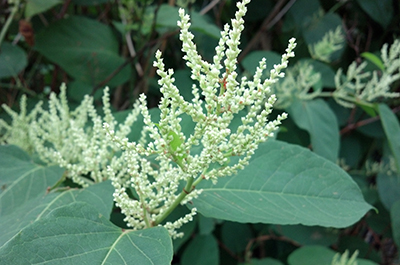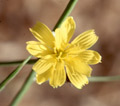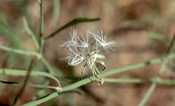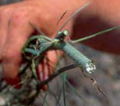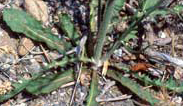Rush skeletonweed
Chondrilla juncea L.
Keys to Identification
- Rush skeletonweed is found in very few locations in Colorado. This perennial member of the Sunflower Family (Asteraceae) forms leafless stems that contain a sticky milky sap. The plants have distinctive downward facing hairs at the base of the plant. Flowers are 1/4 to 1/2 in wide. Seeds have a plume and can be distributed by wind.
This information courtesy of the Colorado Natural Areas Program
Family
Sunflower (Asteraceae)
Other Names
Gum succory, Devil’s-grass Naked weed, Hog-bite
USDA Code
CHJU
Legal Status
Colorado Noxious Weed List A
Notify your county weed supervisor if you find this plant!
Identification
Lifecycle
Perennial
Growth form
Forb
Flower
Flower heads are produced along or at the ends of stems, either individually or in a group of two to three (Rees et al. 1996). Each flower head contains 10 to 12, strap-shaped, bright yellow florets that are flat across the end with distinct lobes or teeth (Rees et al. 1996).
Seeds/Fruit
Seeds are pale brown to nearly black and have a white pappus.
Leaves
Leaves form in a basal rosette, are sharply toothed, and wither as the flower stem develops. Rosette leaves are lance-shaped, deeply lobed, and 2-5 in long. Stem leaves are inconspicuous, narrow and entire (Whitson et al. 1996).
Stems
Mature plants are 1-4 ft tall. Lower stems have short, downwardly bent, coarse hairs. Upper stems are smooth.
Roots
Deep extensive, spreading root system.
Seedling
Small pea-green cotyledons. Secondary leaves quickly emerge and form darker green rosette.
Similar Species
Exotics
There are three forms of rush skeletonweed in the United States, with the forms differing in inflorescence morphology and susceptibility to control measures (Sheley et al. 1999).
Natives
Lygodesmia junceahas pink (occasionally white) flowers.
Impacts
Agricultural
Infestations of rush skeletonweed can reduce livestock and wildlife forage (Sheley et al. 1999). The extensive deep root system makes rush skeletonweed difficult to control (Whitson et al. 1996). The tall, wiry, latex-producing stems also hinder the operation of crop harvest machinery (Rees et al. 1996).
Ecological
Rush skeletonweed can form dense monocultures that displace native plants.
Habitat and Distribution
General requirements
Rush skeletonweed generally inhabits well-drained, light-textured soils. It is capable of growing in a wide range of conditions, but prefers areas that have cool winters, warm summers, with a predominance of winter and spring rainfall (Rees et al. 1996). This species grows in waste places and in overgrazed rangeland especially in the Pacific Northwest and in California. It rarely invades healthy rangeland (Sheley et al. 1999).
Distribution
A few places in Colorado and in other western states.
Historical
Native to southern Europe.
Biology/Ecology
Life cycle
Buds on the root crown or along lateral roots may give rise to new rosettes. Each rosette produces one or more stems, 20-60 in tall, with multiple spreading or ascending light–green branches (Rees et al. 1996). Flowering and seed production occurs from mid-July through frost. Flowers are self-fertile.
Mode of reproduction
Rush skeletonweed can reproduce by both seed and through vegetative propagation.
Seed production
A single multi-stemmed plant may produce as many as 15,000-20,000 seeds.
Seed bank
No information available.
Dispersal
Seeds are readily dispersed by wind, water, animals or humans.
References
Calweed Database. 1997. Noxious weeds project list. California Noxious Weed Control Projects Inventory. Natural Resource Projects Inventory, Information Center for the Environment, University of California, Davis. Available: http://endeavor.des.ucdavis.edu/weeds/
Heap, J.W. 1993. Control of rush skeletonweed with herbicides. Weed Technology 7:954-959.
Rees, N.E., P.C. Quimby Jr., G.L. Piper, E.M. Coombs, C.E. Turner, N.R. Spencer, and L.V. Knutson (editors). 1996. Biological control of weeds in the west. Western Society of Weed Science in cooperation with USDA Agricultural Research Service, Montana Department of Agriculture, and Montana State University.
Sheley, R.L., J.M. Hudale and R.T. Grubb. 1999. Rush skeletonweed. In: Biology and management of noxious rangeland weeds. Oregon State University Press, Corvallis. pg. 308-314.
Supkoff, D.M., D.B. Joley, and J.J. Marois. 1988. Effect of introduced biological control organisms on the density of Chondrilla juncea in California. Biological Control Services Program, California Department of Food and Agriculture, and Department of Plant Pathology, University of California, Davis.
Whitson, T.D.(ed.), L.C. Burrill, S.A. Dewey, D.W. Cudney, B.E. Nelson, R.D. Lee, R. Parker. 1996. Rush skeletonweed. Weeds of the West. Western Society of Weed Science, in cooperation with the Western United States Land Grant Universities Cooperative Extension Services, Newark CA. pg. 99.

